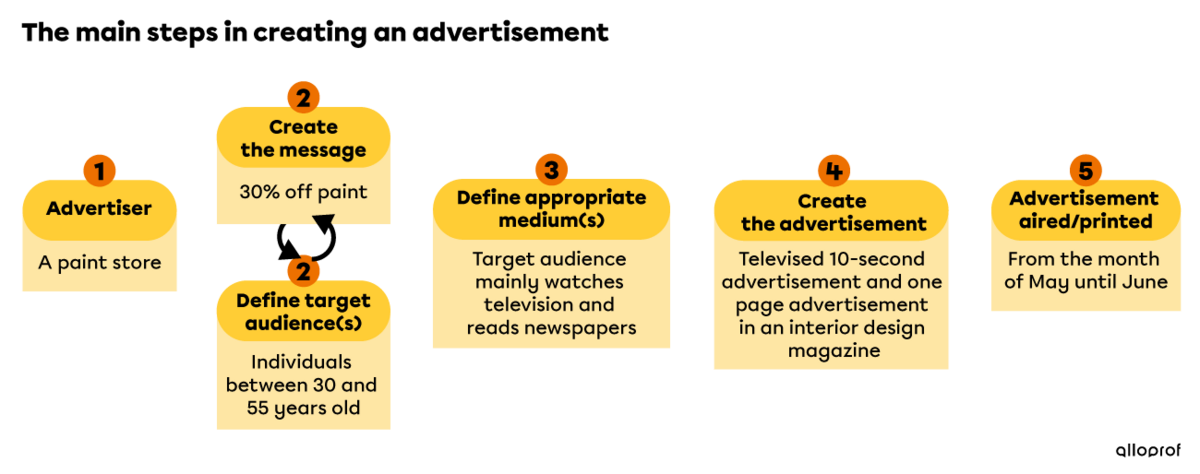Advertising fulfills a communication need for an advertiser, whether a company, an organization or a government. Its message is crafted for a target audience and a chosen medium with a specific objective in mind. Advertising can be a great source of influence.
Advertisers are the party who wants to communicate a message from a company, a private organization or a government. The advertising is initiated by the advertiser, who calls on specialized resources, like a communication firm. The resource helps the advertiser structure the message, identify the target audience and choose the right media (TV, Internet, newspapers and magazines or billboards).
Informative Advertising
Informative advertising uses information, including the price, interesting features and where to buy it, to promote a product or service.
A berry farm advertises that the price of berries will be lowered for a few days. To buy them, you must go to the farm’s stall at the farmers’ market.
Persuasive Advertising
Advertising that leaves out the features of a product or service but appeals to your emotions and desires is persuasive advertising. It emphasizes the points that might encourage you to consume the product or service.
A farm advertises the exceptional taste of its apples to encourage people to buy them.
Social Marketing
Advertising is not just about selling products and services. It can also try to make you more aware of social issues and encourage you to change your behaviour. This is called social marketing.
An advertising campaign by a health organization may feature posters warning people about the consequences of eating a lot of junk food.
Every day, you see advertisements in bus shelters, on the Internet, on television and sometimes even in bathroom stalls. Advertising is everywhere around us, appearing in different forms, but the goals are essentially the same.
There are four primary advertising goals:
Advertising can have many objectives. However, one of these represents a central goal while the others are secondary.
Inform
Give information to the target consumer about the product to encourage sales.
Information is the core element of informative advertising, as in the example you see here. You will see a product feature, the address and the operating hours of the stall.

To Raise Awareness
Appeal to your social or environmental conscience to draw your attention to an issue.
This is a very common objective in social marketing.
There are many issues. In the example below, sustainable agriculture is the focus.

To Change Behaviours
The goal is to encourage you to ask questions, to choose one product or service over another or to adopt better lifestyle habits or safe behaviours.
This is another objective of all three types of advertising.
As in the example above, they show you a behaviour to adopt regarding your diet and encourage you to take action.

To Create Wants Related to a Need
To make people interested in using a product or service when this desire did not exist before.
This is a very common goal in persuasive advertising, but it exists in the other types of advertising too.
The strawberries could be presented in a very appetizing way to make you want to go out and buy some.

Advertising companies use a number of strategies to make you remember their message and to push you to consume the product or service they are advertising.
Among other things, they can:
- Appeal to an emotion, whether laughter, surprise or empathy. When you hear or see an advertisement that surprises you and makes you laugh, you will likely remember it and want to share it with your friends and family. As a result, more and more people will know about the advertised product or service. Advertisements also try to get you to like the company that makes the product or provides the service.
- Repeat the same message and create an easy-to-remember slogan. You might remember a catchy company name or restaurant slogan that you have read or heard year after year.
- Show an ideal world so the product or service appears to have a positive impact on family relationships, to create happiness or lead to a better life balance, for example.
In one poster, a company selling strawberries shows a group of friends sitting around a table in a park on a sunny day. Everyone is enjoying strawberries and every face is smiling and healthy.
This example involves several concepts—friendship, popularity, happiness, health—to try to make you think that eating strawberries will bring you happiness.
- Compare their product with those of competing companies to show how much better their’s is. For example, an advertisement claims that its strawberries are redder and sweeter than the best-selling brand in Quebec.
- Influence by using public figures as role models. Through their Facebook, Instagram or Snapchat accounts, these famous people (influencers) promote a specific product. They may even appear on a poster with the product.
When creating an advertising campaign, advertisers must ask themselves: “Who am I targeting?” This is an important question because it impacts the objectives of the advertising and the choice of advertising strategy and medium.
Sometimes, an advertisement tries to reach everyone, but most of the time it targets a specific age group. This is a way for advertisers to tailor the message to the likes and interests of the people they want to reach. The message is more likely to be understood and be effective.
An advertiser who wants to address young adults will do some research to become more familiar with that age group. What are their values? What issues are important to them? How do people in that age group communicate with each other?
An advertiser needing to communicate the opening of a new extreme ride will mainly target young adults.
Knowing the target audience also helps advertisers choose the right medium for the advertising.
The medium is used to bring the message or advertisement to its target audience. Several questions could be asked: What is the best medium to reach my target audience? Is it a billboard near the highway? Commercials on TV? Social media ads?
If advertisers want to reach young adults, they will be more likely to place advertisements on the Internet than in the newspaper, because the ads are more likely to reach a younger audience online.
On the other hand, if advertisers want to reach retired people, they might choose to advertise on television during programs that are popular among this group.
An advertisement is created based on the characteristics of the people it is designed to reach—the target audience—and on the message that needs to be communicated.
It is then important to decide on the best time to circulate the advertisement. Spring is the ideal time to advertise above-ground pools, when summer is just around the corner, as opposed to the fall when cold weather is coming.
As mentioned, there are several steps to carry out before circulating an advertisement. They are summarized in the diagram below.

Advertisements must comply with several laws and regulations. The primary law in Quebec is the Consumer Protection Act.
Under this law, it is forbidden to:
- Omit an essential fact or piece of information: A car dealer cannot advertise an attractive discount without mentioning that, in order to benefit from it, the car has to be paid for upfront, in full..
- Rely on dishonest scientific data: It is illegal to advertise a beauty product by stating that 100% of the people interviewed were satisfied with the product if the survey included only seven people, all of whom were employed by the company that created the product.
- Target young children: This law prohibits advertising directly to children under the age of 13.
See the website of the Office de la protection du consommateur for more details.
The Consumer Packaging and Labelling Act is administered by the Competition Bureau, a federal agency that enforces several consumer-related laws. This law ensures that information about a product is clear and accurate so that you can make an informed choice. It identifies the information that must appear on a package, including the name of the product, its net quantity and the supplier’s identity.
Merchants are also responsible for posting prices and respecting the advertised price. The advertised price must include all costs to be paid to obtain the goods or services except GST and QST. Rules need to be followed when there is an error between the advertised price and the price to be paid at the cash register. Read more about the Price Accuracy Code.
Collectif, Profil, p. 12-18